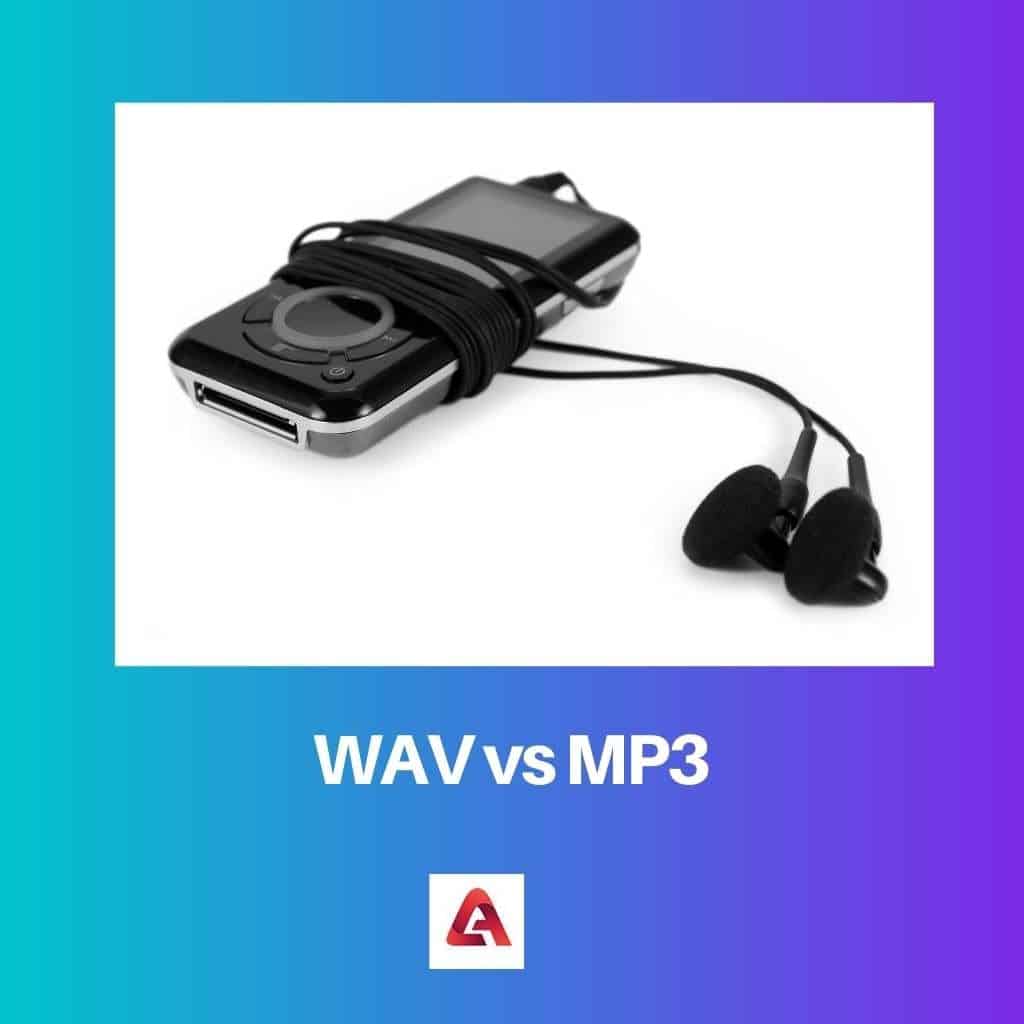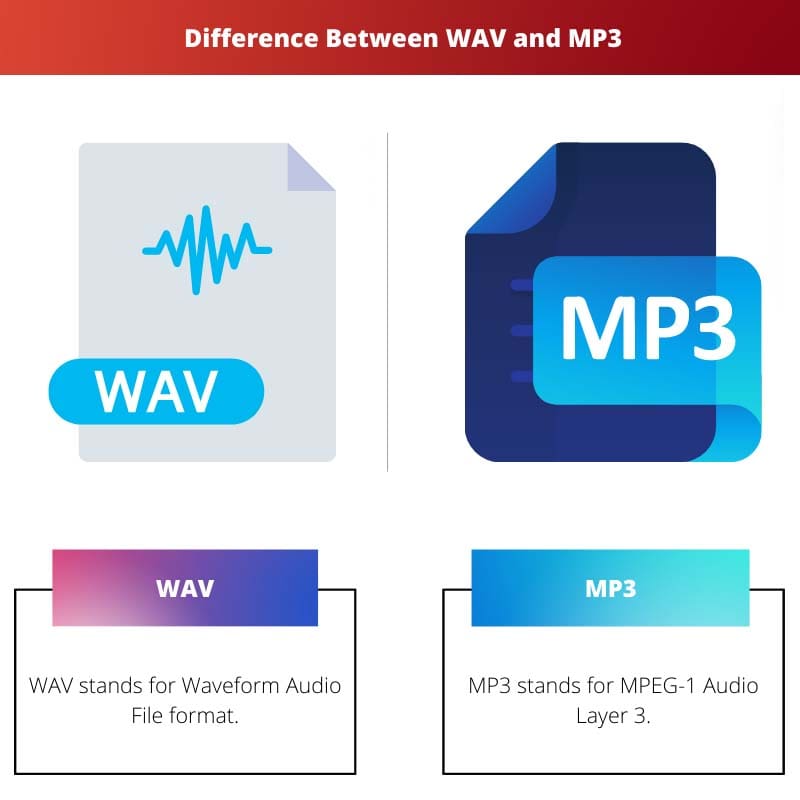Audio files are the same as any other computer files. They have digitally created copies of the analog audio signals fed into a computer.
Depending on the level of clarity and sharpness required, audio files can be stored in different file formats with different compression ratios. Highly compressed files may sometimes lose their clarity.
Key Takeaways
- WAV is an uncompressed audio format that provides high-quality sound but takes up a lot of storage space, while MP3 is a compressed audio format that sacrifices some sound quality for smaller file sizes.
- WAV files are ideal for recording and editing music or audio, while MP3 files are better suited for streaming or sharing audio over the internet.
- MP3 has become the most popular audio format due to its convenience and compatibility with various devices. In contrast, professional audio engineers use WAV for its superior sound quality.
WAV vs MP3
WAV is an uncompressed and lossless audio file format that is widely used for storing high-quality audio data. WAV files are capable of preserving the original audio quality. MP3 is a compressed and lossy audio file format that is widely used for storing and transmitting digital audio data.

The WAV file format is used when high-quality music is desired. In this file format, the audio files are not compressed.
Thus the quality of the audio files remains intact. As the files are not compressed, this file format takes up a lot of space for storing the audio file.
MP3 is the most common file format used for storing and transferring audio data. The format uses an algorithm to compress the audio files for storage.
As the audio is compressed, the quality of the file decreases. The audio further decreases with higher compression, and the file may sound distorted.
Comparison Table
| Parameters of Comparison | WAV | MP3 |
|---|---|---|
| Definition | WAV stands for Waveform Audio File format | MP3 stands for MPEG-1 Audio Layer 3 |
| Function Format | The audio file is uncompressed | The audio file is largely compressed |
| Quality | The sound quality of the original audio signals is retained | Sound quality is decreased heavily |
| Application | Used only in high-quality CDs, professional recording, etc | The most common audio format used for storing and transferring songs |
| Developer | Microsoft and IBM | Moving Pictures Experts Group |
What is WAV?
WAV stands for Waveform Audio File Format. It is a digital audio file format used for storing high-quality audio files.
It is primarily used for making high-quality CDs and in professional recording sessions, where the quality of the file is very important. WAV file format creates an uncompressed audio copy.
As the audio files are not compressed, the quality of the original sound signals is retained in the copy. Thus a high-quality audio copy is obtained.
Because of the uncompressed storing nature of the WAV file, WAV files require a lot of disk space for storing the audio. Thus WAV files are larger in size for single audio files than other file formats such as MP3.
Because of this, WAV files are not used as regularly as MP3 for storing songs. Because of the file size, transferring the files from one device to another by Bluetooth or through the internet is also impossible.
The file quality is very high in WAV format, and thus it is mostly preferred by professional recording studios and other establishments for recording and storing music.
It also stores high-quality audio in professional CDs for recording artists.
What is MP3?
MP3 stands for MPEG-1 Audio Layer-3 file format. The Moving Pictures Experts Group created the file format. It is the most common file format for storing and transferring audio files.
It is an algorithm-based storing format that uses an algorithm to compress the audio files for storing. Thus in this file format, the audio file is compressed before it is stored.
Compression is produced by using a lossy compression algorithm, which reduces the quality of the file. Thus in this file format, the audio file quality gets reduced. Because of the reduction in file quality, the file might sound distorted when played.
Thus this format type is not used in a professional environment. This file format is used for storing music files on personal devices and also for sharing files from one device to another.
Because of the compression, the audio file size is reduced to a high degree. This makes sharing the file possible via Bluetooth or the internet.
This file format is useful for storing large sets of data as the size of individual files is reduced to a large degree, making it possible to store multiple audio files in the same disc location.

Main Differences Between WAV and MP3
- WAV stands for Waveform Audio File format. MP3 stands for MPEG-1 Audio Layer 3.
- In WAV file format, the audio file is not compressed. In MP3 file format, the audio file is heavily compressed.
- In WAV format, the sound quality of the original audio is retained in the copy. In MP3 format, the sound quality is highly reduced.
- WAV file format is used only in for professional recording sessions and for storing the original recorded file in CDs. MP3 is the most common file storage format, and it is used for storing music files in personal devices and also for sharing files through the internet, Bluetooth, etc.
- Microsoft and IBM first created the WAV format. Moving Pictures Experts Group created an MP3 file format.

- https://ieeexplore.ieee.org/abstract/document/6288233/
- https://link.springer.com/chapter/10.1007/978-3-642-03070-3_44
- https://books.google.co.in/books?hl=en&lr=&id=O9bcwTHMpN0C&oi=fnd&pg=PR7&dq=MP3+format&ots=BjvRV5sJE1&sig=klK3OVvDR0_fdhdj4vgIXX3WI_4
- https://ieeexplore.ieee.org/abstract/document/769875/



